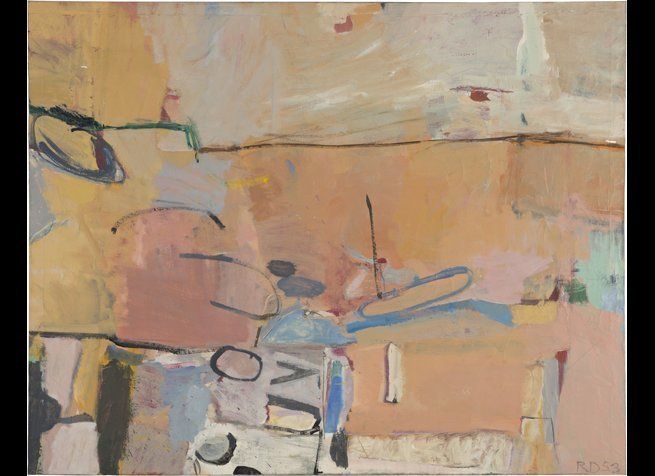Photos courtesy of The Richard Diebenkorn Foundation.
We know (and love) Richard Diebenkorn because of his iconic Ocean Park series, which he began when he moved to Santa Monica from Berkeley in 1966. What we don't know as well (for the simple reason it's never been assembled in any meaningful way until now) is the work he did in Berkeley from 1953-1966.
Representing a collaboration between the Fine Arts Museums of San Francisco and the Palm Springs Art Museum, "Richard Diebenkorn: The Berkeley Years, 1953 - 1966" is the first exhibition that authoritatively examines Diebenkorn's work of this period. This period is significant because it shows how Diebenkorn moved from Abstract Expressionist work to work relatively more representational (landscape, figure, still life). This work culminated in what's come to be known as Bay Area Figuration. Just as you know and love Diebenkorn for his Santa Monica work, this exhibition of Berkeley work will ensure that you will walk away knowing (and loving) him even more.
The exhibition is like a cathedral: large (over a hundred pieces) but peaceful, more a series of intimate alcoves than sweeping chambers. This suits the work, which typically features views through windows or open doors. You don't get the sense that the exhibition tries to deify Diebenkorn, the most humble guy imaginable. It's more of a show that wants us to get to know each piece on a one-on-one, first name basis. When you leave you feel that you've been in the company of someone with a sure hand, a measure of grace, an artist whose style evolved from one stylistic trope to another, not out of crisis or insecurity, not because of any external pressure, but simply because, damn it, he wanted to.
The paintings and drawings are splendid, the paintings and drawings are magnificent. They require Mecca-like pilgrimages to the desert that is Palm Springs. We see his evolution from the Abstract Expressionist work he did in Albuquerque (MFA, University of New Mexico) to the increasingly representational work he did upon his return to the Bay Area. "An oscillation between these two seemingly opposite poles," is how Timothy Anglin Burgard, in his catalogue essay "The Nature of Abstraction: Richard Diebenkorn's Berkeley Years," describes the exhibition's dynamic.
If the work is dreamy, then the installation is the comfortable bed on which you're doing the dreaming. If you look carefully at the wall to the left of the passage prior to where the show officially begins, you'll see pieces of Diebenkorn's straight-out abstract work (accompanied, mercifully, by non-obtrusive wall text). On the wall to the right of the passage hangs his fully realized figurative work. It's as if the exhibition designer wanted to frame the show before we entered, so we'd occupy the middle ground between, on one hand, the prevailing orthodoxy of Abstract Expressionism and, on the other hand, the apostasy (to many) of representational work.
Really, though, if you spend time with the work, engage with it the way De Kooning engaged with his paintings (studiously, up close, judiciously, at a distance), it's not so much the uniqueness of the show (first comprehensive look at the Berkeley work), the idea behind the show (top notch), or even the work itself (stellar) that stays with you, it's the works' integrity, the way it shows us how to live in each moment with great intensity and total commitment. It took great courage for Diebenkorn to abandon his commercially and critically successful Abstract Expressionist work. He didn't understand why collectors railed and critics decried the move but then neither did he care. Whether we're artists trying to find our voice or just plain folk trying to find our way, he gives us, if not explicit permission then at least non-judgmental inspiration to evolve, to explore, to grow, as long as we do it with the utmost sincerity and Zen-like commitment to whatever concerns us at a particular present moment.
Museum hours are 10am - 5pm, Tuesday, Wednesday, and Friday, Saturday, and Sunday; 12pm - 8pm, Thursday. The exhibition runs until February 16. The Museum is located at 101 N. Museum Drive, Palm Springs, CA 92262. For more information, call (760) 322-4800 or visit www.psmuseum.org.
